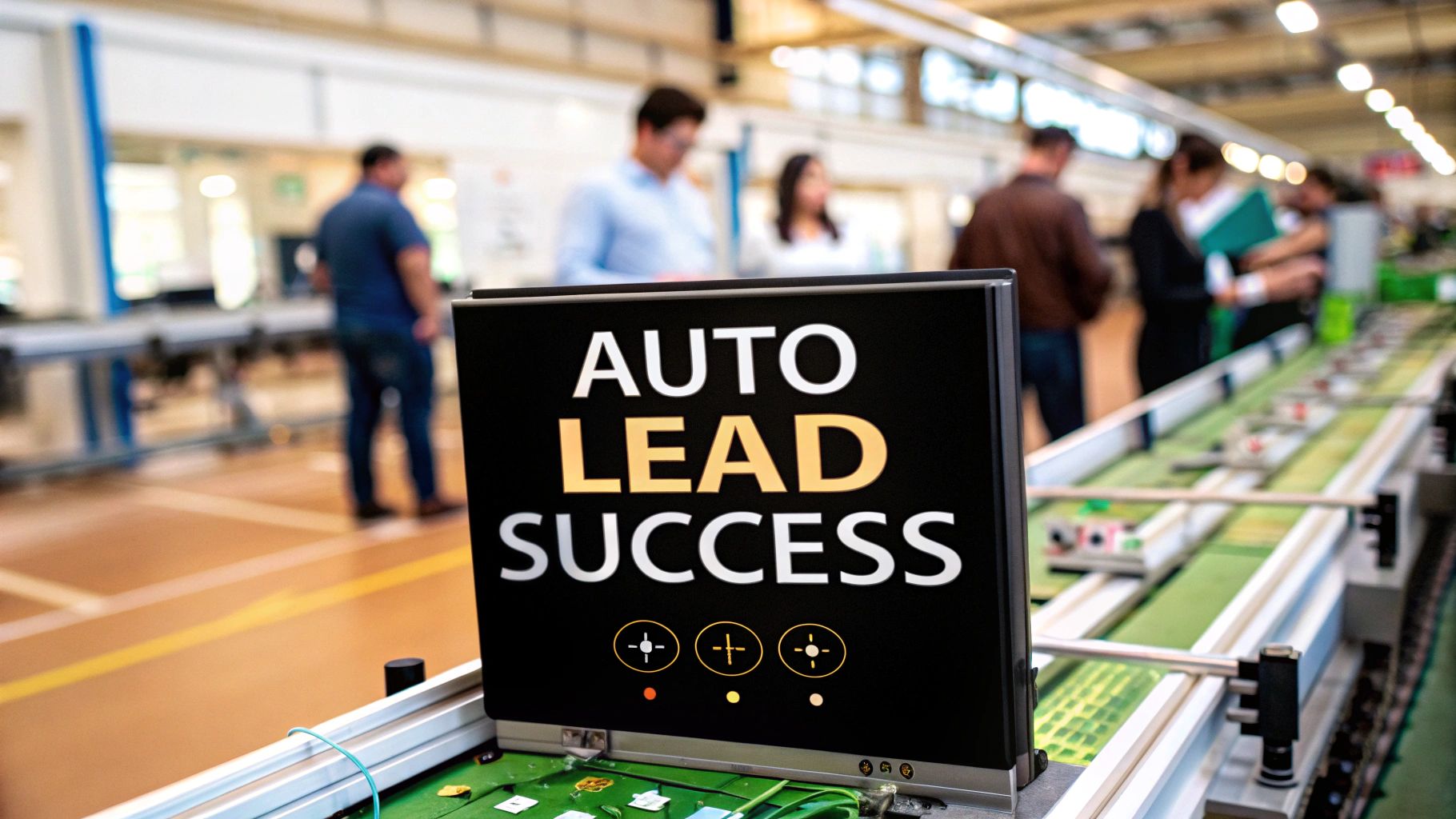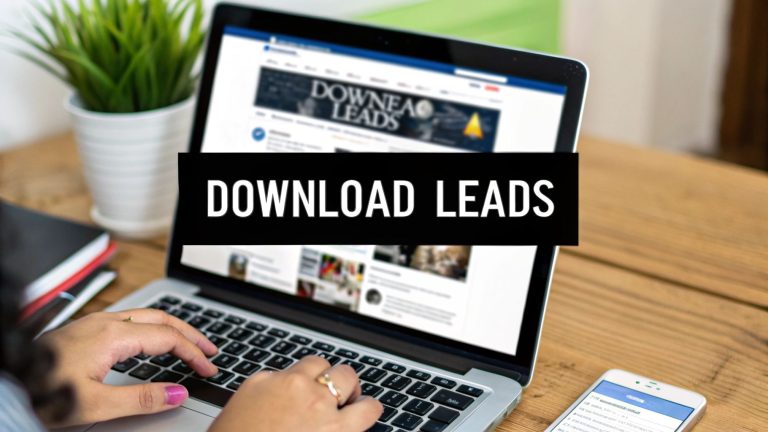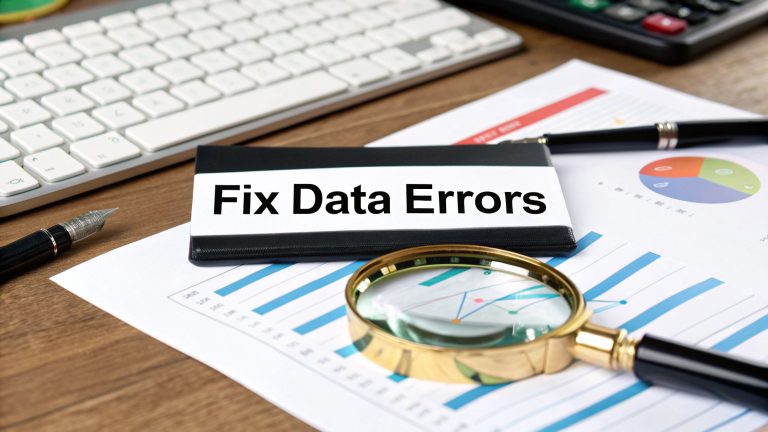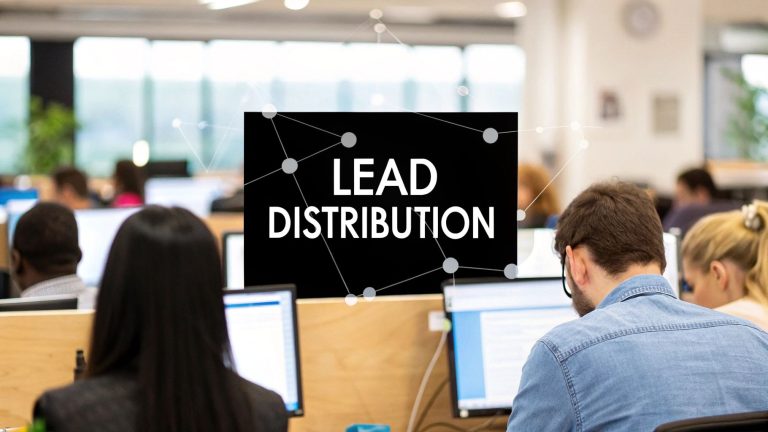Your Guide to Auto Lead Generation Success
Let's be real, manual prospecting is a grind. Cold calling, endless searching on LinkedIn, digging through databases… it's a time-suck that rarely pays off like it should.
Now, imagine a system that works for you 24/7, finding your ideal customers while you focus on what you actually do best—that’s auto lead generation in a nutshell. This isn't just about a single tool; it's a complete business engine built to save you time, scale your efforts, and grow your revenue on autopilot.
What Is Auto Lead Generation Really?
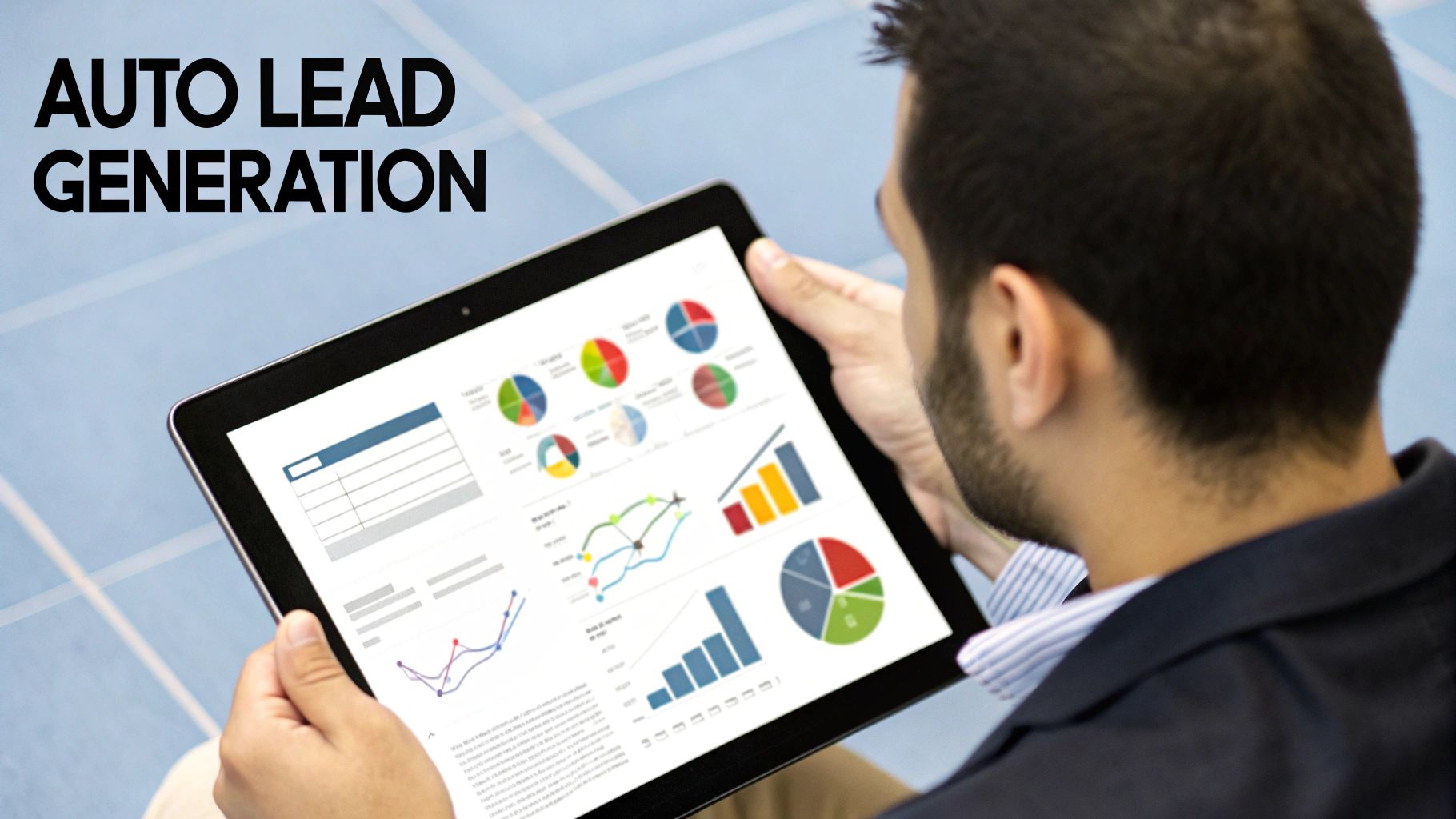
Think of auto lead generation as a smart fishing net. Instead of casting a line over and over, hoping for a bite, you set up a sophisticated net that automatically catches and sorts the most valuable fish (your leads) for you.
You're essentially building a machine that attracts and qualifies prospects for you, freeing your team from those mind-numbing, repetitive tasks. It’s a fundamental shift from actively hunting for leads to creating a system that brings them right to your doorstep. The goal is to learn how to generate more leads with a consistent, predictable flow.
The Core Components of an Automated System
A solid auto lead generation strategy isn't just about flipping a switch on some software. It’s a framework built on a few key pillars that have to work together perfectly. Each piece plays a critical role in turning a curious website visitor into a sales-ready prospect.
The main parts include:
- Automated Lead Capture: This is your "net." Using things like website forms, chatbots, or dedicated landing pages to grab contact info from interested people without you lifting a finger.
- CRM Integration: As soon as a lead is captured, their info is zapped directly into a Customer Relationship Management (CRM) system like LeadSavvy Pro. This keeps everything organized and tracks every interaction automatically.
- Automated Nurturing: This is where the magic happens. You can send personalized, pre-scheduled follow-up emails or messages to educate leads and gently guide them toward making a purchase.
When these elements work in sync, they create a seamless journey for your potential customer and give your team incredibly valuable data. Just look at the numbers.
Lead generation automation is a top priority for about 50% of marketers. And it's no wonder why. While businesses generate around 1,877 leads per month, a shocking 44% of sales reps admit they're too swamped to follow up on them. This gap is exactly where an automated system becomes a game-changer.
Manual vs. Automated Lead Generation at a Glance
So, what's the real difference between the old way and the new way? Let's break it down. The table below shows just how stark the contrast is when you compare manual efforts to an automated system.
| Aspect | Manual Lead Generation | Auto Lead Generation |
|---|---|---|
| Effort | High, repetitive daily tasks | Low, "set it and forget it" |
| Speed | Slow, often delayed follow-up | Instant, real-time engagement |
| Scale | Limited by manpower | Virtually unlimited |
| Consistency | Inconsistent, depends on effort | Predictable, 24/7 operation |
| Data Tracking | Prone to errors, often messy | Centralized and accurate |
As you can see, automation doesn't just make things easier; it makes them better, faster, and far more reliable. It's a true competitive advantage.
Why This System Is Essential for Growth
Automating your lead generation process does way more than just save you a few hours. It builds the foundation for scalable, predictable growth.
When you have a consistent way to attract and nurture leads, you can actually forecast your sales pipeline with surprising accuracy. This predictability means you can make smarter, more confident investments in your marketing and sales efforts.
Ultimately, auto lead generation gives you a serious edge. It allows for lightning-fast response times and personalized communication at a scale that's impossible to achieve manually. It ensures no potential customer ever falls through the cracks and that your team’s energy is always focused on the opportunities that are most likely to close.
The Four Pillars of an Unstoppable System
A powerful auto lead generation system isn't just one piece of software; it's a strategic framework built on four crucial pillars. When these parts work in harmony, they create a smooth, efficient machine that turns complete strangers into qualified leads.
Think of it like building a high-performance engine. Every single part has to be perfectly tuned and integrated to get maximum power and reliability. Let's break down these four pillars to see how they create a system that drives real, measurable results for your business.
Pillar 1: Targeted Traffic
The first and most critical pillar is Targeted Traffic. You can have the slickest automation in the world, but if the right people never see it, it’s completely useless. This pillar is all about attracting your ideal customer profile (ICP) to your digital front door—whether that's your website, social media, or a specific landing page.
The goal isn't just more traffic; it's the right traffic. This is where a multi-channel approach really pays off:
- Search Engine Optimization (SEO): By tuning your website content for the keywords your ideal customers are actually searching for, you pull in organic traffic from people who are actively looking for a solution.
- Pay-Per-Click (PPC) Advertising: Platforms like Google Ads and social media ads let you target users with surgical precision based on their demographics, interests, and online behavior.
- Social Media Marketing: Engaging with your community on the platforms where they already hang out helps build brand awareness and guides interested followers toward your lead funnels.
Without a steady flow of qualified visitors, your auto lead generation system has no fuel to run on.
This infographic visualizes the complexity and synergy of a well-built system, showing how various tools and nodes connect in a modern setup.
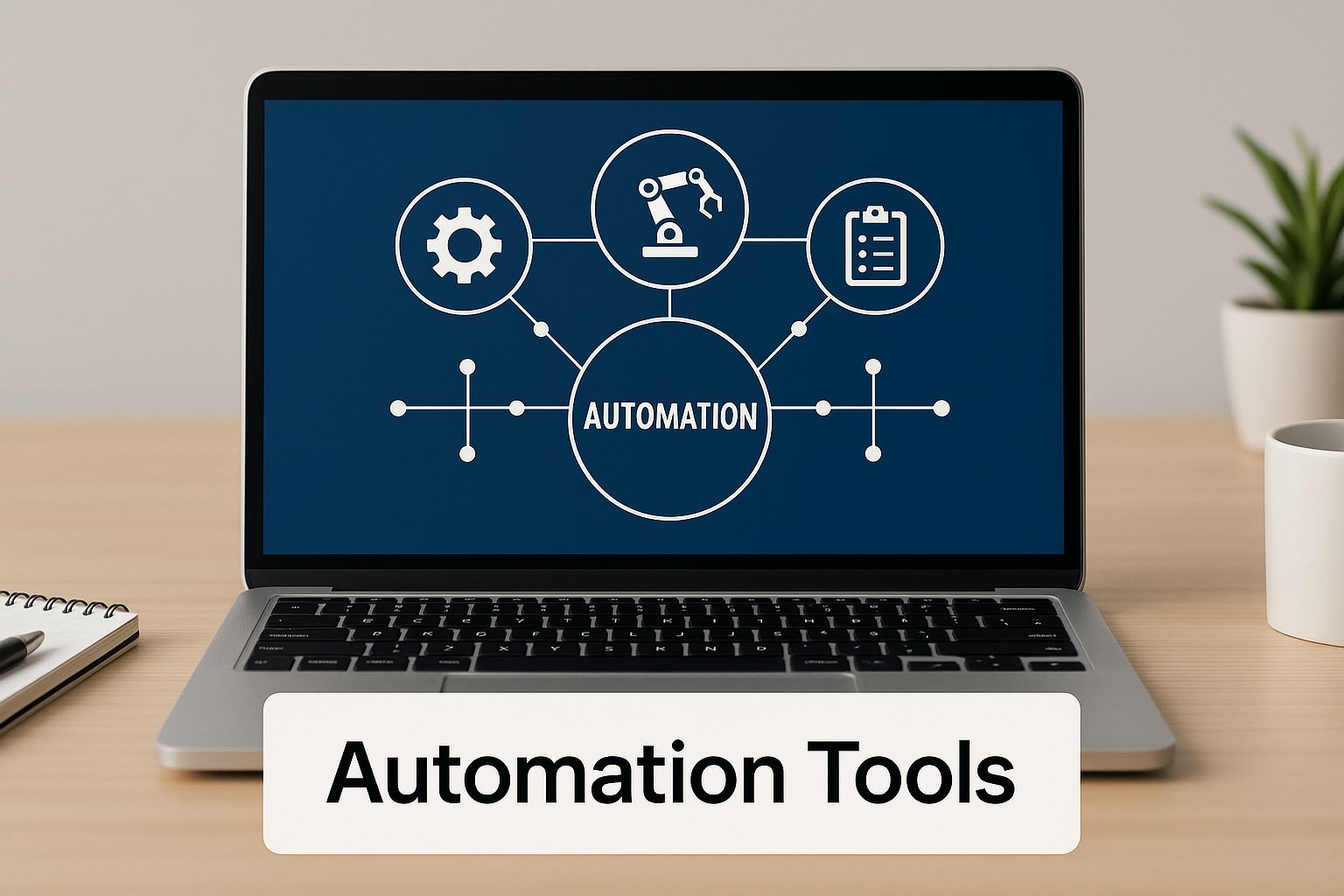
The key takeaway here is that a winning auto lead generation strategy relies on multiple tools working together, not in isolation.
Pillar 2: High-Converting Capture
Once you have targeted traffic flowing in, the next pillar is High-Converting Capture. This is the moment you turn an anonymous visitor into a known lead by getting their contact information. A weak capture strategy is like a leaky bucket—all that traffic you worked so hard for will just slip away.
The best capture points are designed to be frictionless and offer obvious value.
The core principle is a fair exchange. You have to offer something valuable enough that a visitor is willing to trade their contact details for it. This is where lead magnets like ebooks, webinars, and free tools become your most valuable assets.
Key capture tools include:
- Optimized Landing Pages: These are focused, distraction-free pages with one single goal: to get the visitor to fill out a form in exchange for your high-value offer.
- Interactive Chatbots: Chatbots can engage visitors 24/7, answer common questions, and qualify leads in real-time, grabbing their info through a natural conversation.
- Strategic Forms: Smartly placed forms on your website, like in a blog sidebar or a footer, give you ongoing chances to convert readers who are already engaged.
Pillar 3: Intelligent Nurturing
Getting a lead is just the start. The third pillar, Intelligent Nurturing, is all about building a relationship with that lead over time. Very few leads are ready to buy the second they hit "submit." In fact, research shows that around 50% of leads are qualified but just not ready to make a purchase yet.
This is where automation really shines. With automated workflows, you can send a series of personalized, timely messages that guide your leads along their buyer's journey. This could be educational emails, case studies, or invites to a product demo, all triggered by what a lead does or shows interest in.
Good nurturing keeps your brand top-of-mind and builds trust, so when that lead is finally ready to pull the trigger, you're the first one they call.
Pillar 4: Seamless Integration
The final pillar holding it all together is Seamless Integration. Your auto lead generation tools can't work in separate bubbles. For your system to function as one cohesive machine, all your tools have to talk to each other.
This means connecting your lead capture forms directly to your CRM, like how LeadSavvy Pro syncs with Facebook Lead Ads. When a new lead comes in, it should instantly pop up in your central database, triggering the right nurturing sequence without anyone having to lift a finger for manual data entry.
This integration ensures your sales and marketing teams are always on the same page, with a single source of truth for every lead. You can track every interaction, from the very first click to the final sale.
Building Your First Automated Workflow
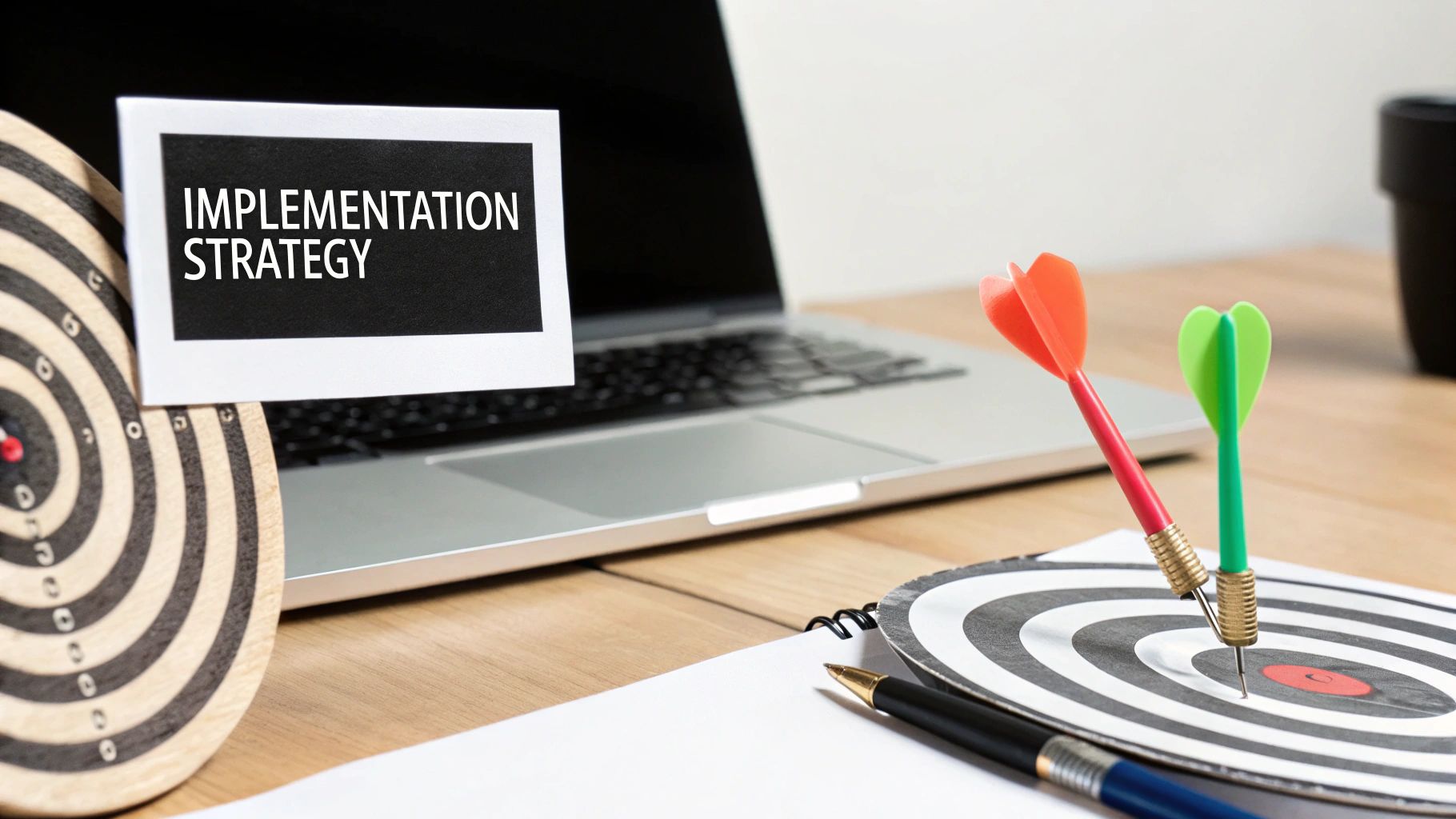
Alright, theory is one thing, but getting your hands dirty is where the magic happens. Let's shift from talking about concepts to actually building your very first auto lead generation workflow from scratch. You'll see just how powerful—and surprisingly manageable—this process really is.
To make this real, we'll follow a hypothetical B2B service company. We'll call them "Innovate Solutions," and their goal is simple: find more project managers who need their efficiency software. By walking through their setup, you can see exactly how all the pieces click together.
Step 1: Define Your Ideal Customer
Before you even think about writing an email or designing a landing page, you have to know exactly who you're talking to. A fuzzy target like "any business that needs help" will get you nowhere fast. You need to nail down a detailed Ideal Customer Profile (ICP).
For Innovate Solutions, they're not just looking for any manager. They get specific:
- Title: Project Manager or Operations Manager.
- Company Size: 50-250 employees. Big enough to have a budget, but small enough that the manager is still feeling the pain of bad processes.
- Pain Points: They’re dealing with missed deadlines, chaotic team collaboration, and a nagging feeling that they can't see what's really going on with their projects.
- Goals: They want to hit deadlines, stay under budget, and look like a hero to their bosses.
This level of detail is everything. It shapes your messaging, your offer, and makes sure you’re speaking directly to the right person’s problems.
Step 2: Create a Compelling Lead Magnet
Now that you know your audience's biggest headaches, you can create something that solves one of them. This is your lead magnet—the valuable thing you give away in exchange for an email address. A lazy "Sign Up for Our Newsletter" just won't cut it.
For our overworked project manager, a killer lead magnet would be something like this:
"The 5-Step Project Rescue Checklist: Your Guide to Getting Troubled Projects Back on Track in 7 Days"
See the difference? It's specific, promises a real result, and hits a major pain point head-on. It feels like a fair trade for their contact info because it offers an immediate win.
Step 3: Set Up an Automated Follow-Up Sequence
This is where the "auto" part really kicks in. Once someone downloads that checklist, you can't just go silent. You need an automated email sequence to start building a relationship and gently guide them toward your solution.
Using a platform like LeadSavvy Pro, you can trigger this sequence the second that lead comes in. A simple but effective flow looks like this:
- Email 1 (Immediately): Deliver the Goods. Send the checklist they asked for. That’s it. Your only job here is to deliver on your promise and build that first bit of trust.
- Email 2 (2 Days Later): Add More Value. Follow up with a related tip or a quick case study. Something like, "Here’s how one company used a similar framework to cut project delays by 30%." This shows you know your stuff.
- Email 3 (4 Days Later): Introduce the Solution. Now it's time to connect the dots. You can smoothly introduce your service as the next step: "While the checklist is a great start, our software can automate this entire process for you. Curious to see how?"
For a deeper dive, our guide on how to automate lead generation covers more advanced strategies for these sequences.
Step 4: Configure Basic Lead Scoring
Let's be honest: not all leads are created equal. Some are just window shopping, while others are ready to buy. Lead scoring is how you automatically tell them apart so your sales team can focus their energy on the hottest prospects.
You just assign points based on what a lead does. For Innovate Solutions, a simple model could be:
| Action Taken | Points Awarded |
|---|---|
| Downloads the Checklist | +10 points |
| Opens Follow-Up Email | +5 points |
| Clicks a Link in an Email | +15 points |
| Visits the Pricing Page | +25 points |
Once a lead hits a certain score—let's say 50 points—the system can automatically flag them as a "hot lead" and shoot a notification to a sales rep. It’s that simple.
By prioritizing leads based on actual engagement, you make sure your team is always talking to the people most likely to convert.
Step 5: Integrate with Your CRM
Finally, you need to make sure no lead ever falls through the cracks. The best way to do that is to integrate your system with a Customer Relationship Management (CRM) tool. This becomes your single source of truth for every single prospect.
When a new lead gets that checklist, their info should instantly pop up in your CRM. Every email opened, every link clicked, and every score change gets logged right on their contact record. This gives your sales team a complete backstory for every person they talk to, empowering them to have smarter, more relevant conversations.
This seamless data flow is the final piece of the puzzle, turning a bunch of separate tasks into a true automated workflow that just works.
How AI Transforms Lead Generation
Think of standard automation like a factory robot on an assembly line. It does the same task perfectly, thousands of times. It’s reliable, but it doesn't think for itself.
Now, what if that robot could learn, adapt, and make decisions on its own? That’s the difference artificial intelligence (AI) brings to the table. AI gives your auto lead generation system a brain, making the whole process smarter, not just faster.
It moves beyond simply following pre-set rules. Instead, AI analyzes data, spots hidden patterns, and tweaks your strategy in real-time. The result is a system that's more efficient, more personal, and far more effective.
Beyond Automation to Intelligent Action
The real magic of AI is its ability to handle tasks that normally require human judgment, but at a massive scale. It’s not about doing things quicker; it’s about doing them smarter. AI adds a layer of dynamic decision-making that rigid, static workflows just can't compete with.
For example, a standard automated email sequence is great. But what if a lead gets your first email, then spends five minutes on your pricing page? An AI-powered system sees that behavior and can instantly change the next email to be about pricing instead of a general intro. That adaptability is what sets AI-driven lead generation apart.
Companies using AI in their lead generation see some frankly stunning results—we’re talking up to a 50% increase in leads and a 47% jump in conversion rates. Why? Because AI can automate complex tasks, uncover deep customer insights, and personalize engagement at the perfect moment.
Core AI Applications in Lead Generation
So, how does this actually work in the real world? AI isn't some fuzzy concept; it's a set of practical tools you can plug into your lead funnel today.
-
AI-Powered Chatbots: Forget those clunky, "I don't understand" bots from a few years ago. Modern AI chatbots offer instant, 24/7 engagement, answering complex questions and qualifying leads through natural-sounding conversations. In fact, about 17% of businesses already use them to handle those first interactions, freeing up sales teams to talk to truly hot prospects.
-
Predictive Lead Scoring: Instead of giving points based on a simple checklist ("opened email = 5 points"), AI sifts through thousands of data points—from demographics to website behavior—to predict which leads are actually most likely to buy. This gives your sales team a dynamic, super-accurate priority list that changes as leads interact with you.
-
Real-Time Ad Optimization: AI algorithms can watch your ad campaigns like a hawk, adjusting bids, targeting, and even ad creative on the fly to maximize your return on ad spend (ROAS). It finds your most profitable audiences and automatically doubles down on what's working, so you don't have to.
To see how AI is specifically revolutionizing the nurturing process, check out this great guide on automated lead nurturing with AI chatbots.
The Future is Adaptive and Personalized
At the end of the day, adding AI to your auto lead generation strategy is about creating a system that listens and responds intelligently. It helps you understand what a customer truly wants and deliver personalized experiences that build trust and drive sales.
You're shifting from a one-size-fits-all shout to a one-to-one conversation—at scale. By learning from every single interaction, AI ensures your marketing gets better over time, creating a powerful, self-improving engine for growth. This is exactly why platforms like LeadSavvy Pro are built to work with these intelligent systems, letting you act on AI-driven insights instantly.
Measuring What Truly Matters for Growth
If you're not measuring your results, you're not marketing—you're just guessing. To make auto lead generation work, you have to get sharp about which numbers you track. It's time to ditch the vanity metrics that make you feel good and zero in on the Key Performance Indicators (KPIs) that prove your system is actually making you money.
Think of it like this: Likes and page views are the shiny new paint job on a car. They look nice, but they don't tell you if the engine is running or if you have enough gas to get where you're going. The KPIs we're about to cover are your dashboard—the gauges that tell you exactly what's working and what's not.
Core Metrics for Your Automated Funnel
So, what should be on your dashboard? A few core numbers will give you a clear picture of your funnel's health and its direct impact on your business. These aren't just fluffy figures; they're the indicators that connect your marketing spend to real-world results.
For a deeper dive, check out our full guide to lead generation performance metrics.
But for now, here are the absolute essentials you need to watch:
- Cost Per Lead (CPL): This is your efficiency score. Simply take your total campaign spend and divide it by the number of leads you brought in. A low CPL is a great sign that your automation is dialed in and not just burning cash.
- Lead Conversion Rate (LCR): This number tells you what percentage of your leads are actually taking the next step you want them to, whether that's booking a demo or hitting the "buy" button. It’s the ultimate test of your lead quality and follow-up.
These two numbers give you a fantastic starting point. But to really fine-tune your machine, you need to look at the crucial handoff point in your funnel.
From Marketing Interest to Sales Opportunity
One of the most common places funnels break is the handoff from the marketing team to the sales team. You might be generating tons of leads, but if the sales team thinks they're junk, you've got a serious problem. Tracking this transition is non-negotiable.
The MQL-to-SQL ratio is your most important internal health check. It measures the percentage of Marketing Qualified Leads (MQLs) that sales accepts as Sales Qualified Leads (SQLs). A high ratio is a beautiful thing—it means marketing is sending over prospects that the sales team is excited to talk to.
If that MQL-to-SQL number is low, it’s a red flag. It could mean your lead scoring is off, your lead magnet is attracting the wrong crowd, or your definition of a "good lead" isn't aligned between departments. This is your cue to get everyone in a room and fix it.
The market for auto lead generation is on track to hit USD 6.38 billion by 2025, driven by the massive shift to digital ads and automation. With that much competition, you can’t afford to fly blind. Understanding the nuts and bolts of your campaign ROI is crucial, and that often means mastering Google Ads conversion tracking to see exactly which ads are driving real business.
Ultimately, it all comes back to revenue. The final, most powerful metric is Customer Lifetime Value (CLV). When you can calculate the CLV of the leads your automated system generates, you’ve hit the jackpot. This single number proves the long-term, tangible ROI of your efforts, making it easy to justify your budget and keep refining your strategy for even better performance.
Best Practices for Sustainable Success
Getting your auto lead generation system up and running is a huge first step. But the real pros know that's just the starting line. To see long-term, scalable growth, you can't just "set it and forget it."
Think of your system like a high-performance race car. You wouldn't just build it and expect to win every race without ever checking the engine or testing new parts, right? To stay ahead of the competition, you have to keep tuning and refining your approach.
Constantly Test and Optimize
One of the best habits you can build is A/B testing. This is just a simple way of comparing two versions of something—like an email subject line or a landing page headline—to see which one performs better. It’s how you stop guessing what works and start knowing.
Your main testing grounds should be:
- Landing Pages: Test your headlines, call-to-action (CTA) button colors, form lengths, and images. Sometimes a tiny tweak can lead to a huge lift in conversions.
- Email Campaigns: Play around with different subject lines, send times, and content formats. Does an email from "Sarah at Company X" work better than one just from "Company X"? Test it!
The goal of A/B testing isn't to find one perfect formula. It's about building a culture of small, consistent improvements. Over time, these little wins compound into massive gains in lead quality and conversion rates.
Maintain Excellent Data Hygiene
Your contact list is the fuel for your automation engine. If that fuel is dirty, the whole system sputters. This is where data hygiene comes in—it’s just the practice of keeping your list clean, accurate, and effective. Bad data leads to bounced emails, wasted ad spend, and analytics that you can't trust.
Get in the habit of cleaning your list regularly. Remove invalid emails, fix typos, and merge duplicate contacts. Even more importantly, have a process for removing unengaged subscribers—anyone who hasn't opened or clicked an email in over 90 days. Keeping them on your list can actually damage your sender reputation and hurt your email deliverability.
Personalize Ethically and Effectively
Automation lets you personalize at scale, but there's a fine line between being helpful and just being creepy. Ethical personalization means using data to provide real value. Instead of just dropping a lead's name into a generic template, use their behavior to shape the conversation.
For example, if a lead downloaded a guide about a specific product feature, your follow-up email should be about that feature—not a long-winded story about your company. It shows you're actually paying attention to what they need. To dive deeper into this, check out our guide on marketing automation best practices.
When you focus on being relevant, you build trust and turn automated messages into genuinely helpful conversations.
Common Questions About Auto Lead Generation
Diving into automated lead generation can feel like a huge step, and it's totally normal to have a few questions buzzing around your head. Business owners often ask me about the cost, the setup time, or how their customers will react.
Let's clear the air and tackle some of the most common worries I hear.
One of the biggest myths is that this stuff is only for giant companies with bottomless budgets. That couldn't be further from the truth. Modern automation tools are built to be affordable and grow with you, putting real power into the hands of small and medium-sized businesses. The trick is to start small—pick one simple workflow and build from there.
Is This Too Impersonal for Customers?
I get this one a lot. People worry that automation will sound robotic and turn customers off. And honestly? It can, but only when it’s done badly. The whole point of a modern auto lead generation system is to deliver personalization at scale.
By using data—like a lead's browsing history or the specific guide they just downloaded—you can send them incredibly relevant, timely messages that feel helpful, not spammy. It’s all about talking to someone about their specific interests at the perfect moment. That’s far more personal than any generic email blast you could send.
A well-designed automated system doesn't replace the human touch; it amplifies it. It frees up your team to have meaningful conversations with your hottest leads, making every real interaction count.
How Quickly Can I Expect to See Results?
Ah, the million-dollar question. While you can start catching new leads almost the second you turn on a campaign, seeing a real impact on closed deals takes a bit more patience. The timeline really depends on your industry's sales cycle.
If you have a short sales cycle, you could see the results you're looking for in just a few weeks. But for B2B businesses with a longer decision-making process, it might take anywhere from one to six months to see a major bump in revenue.
My advice? Track leading indicators like Marketing Qualified Leads (MQLs) from day one. It's the best way to measure your initial momentum and know you're on the right track.
Ready to stop manually downloading leads and start converting them faster? LeadSavvy Pro syncs your Facebook leads directly to a Google Sheet or CRM in real-time. Sign up for your free plan at LeadSavvy Pro and automate your lead flow in minutes!

